Andrew Wireless System M1719PADV ION-M Remote Unit for cellular systems User Manual Installation Instruction
Andrew Wireless System ION-M Remote Unit for cellular systems Installation Instruction
User Manual
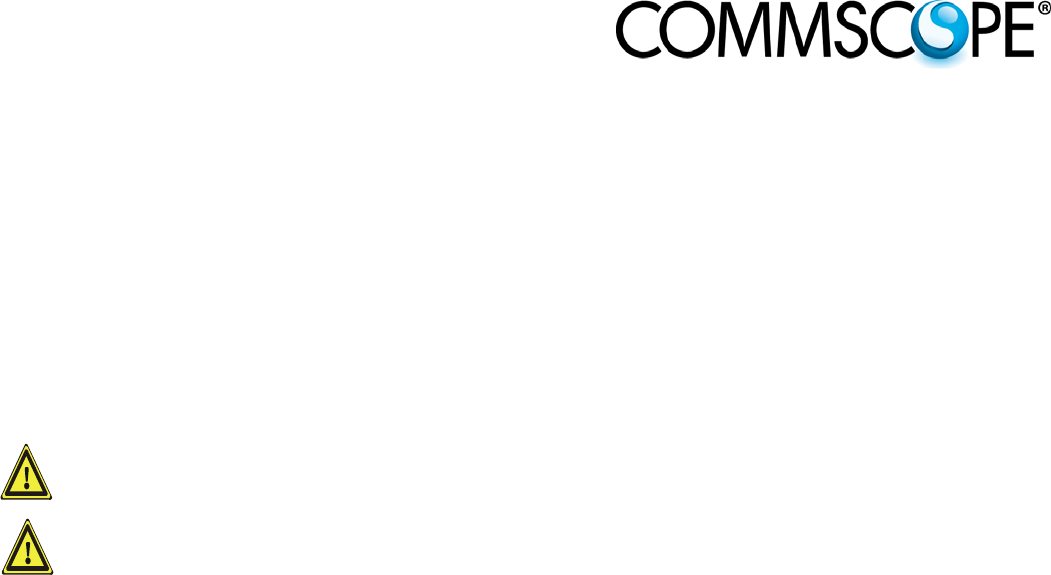
Installation Instruction
The Remote Unit, Extension Unit or Master Unit has to be
mounted by proffessionel / special trained installer.
1.1. MECHANICAL INSTALLATION
1.1.1. Health and Safety for Mechanical Installation
Read and observe chapter 1.3 Health and Safety
1. Caution: Risk of injury by the considerable weight of the unit falling. Ensure there is
adequate manpower to handle the weight of the system.
2. Caution: Risk of serious personal injury by equipment falling due to improper installation.
The installer must verify that the supporting surface will safely support the combined load
of the electronic equipment and all attached hardware and components. The screws and
dowels (wall anchors) used should also be appropriate for the structure of the supporting
wall.
1.1.2. Property Damage Warnings for Mechanical Installation
1. Attention: Do not install the unit in a way or at a place where the specifications outlined in
the Environmental and Safety Specifications leaflet of the supplier are not met.
2. Attention: Due to power dissipation, the Remote Unit may reach a very high temperature.
Ensure sufficient airflow for ventilation.
3. Notice: Exceeding the specified load limits may cause the loss of warranty.
4. Notice: When connecting and mounting the cables (RF, optical, mains, ...) ensure that no
water can penetrate into the unit through these cables.
5. Notice: Also observe all additional rules or restrictions regarding mounting that depend on
the type of Remote Unit. For details refer to section 7.2.2 Mechanical Specification. Install
the unit vertically with the fan unit at the top. A maximum tilt angle of 25° from a vertical
position must be kept, as in the following illustrations:
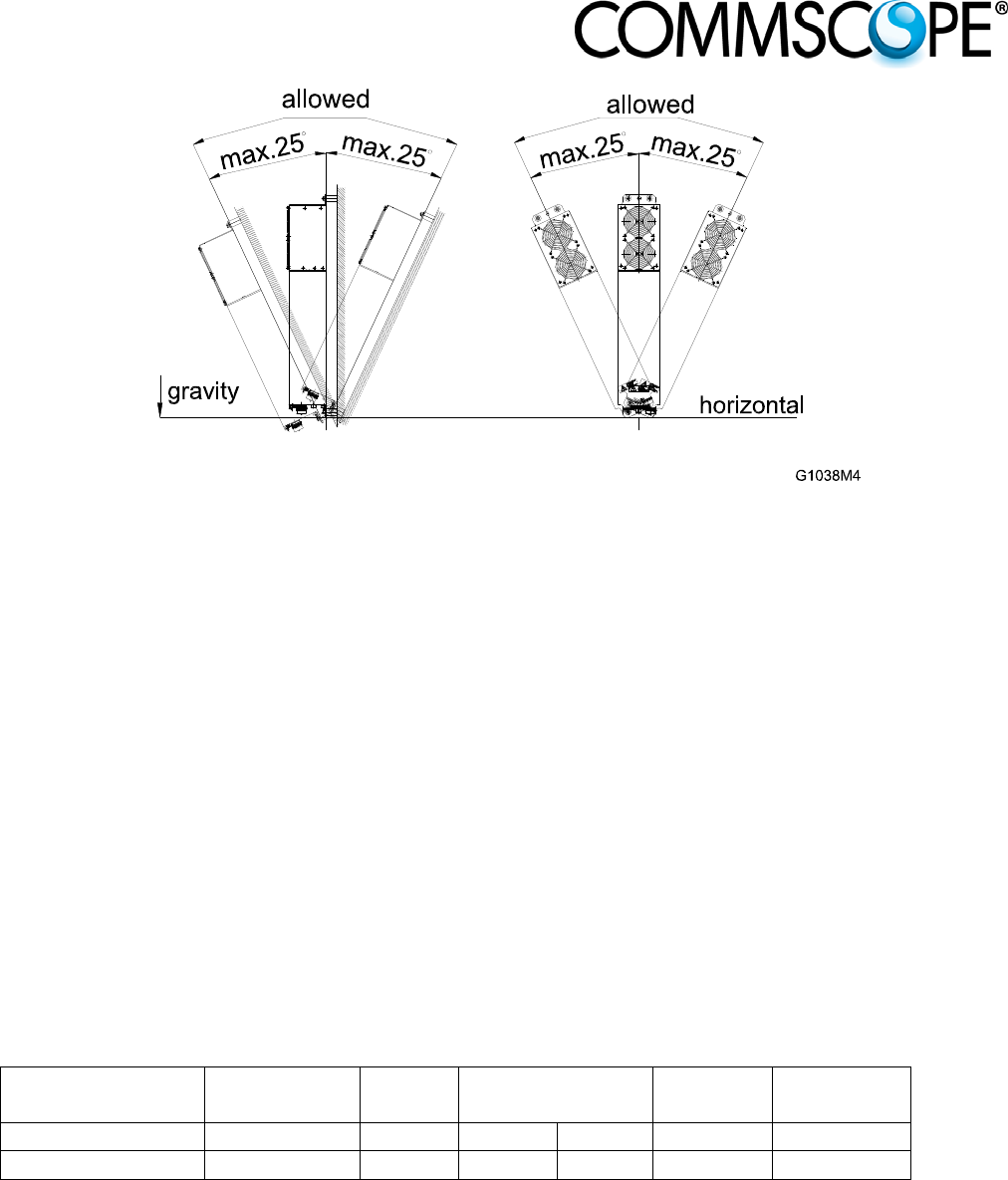
6. Notice: A spacing of 40 mm (1.58 inch) around the unit is required.
7. Notice: To ensure sufficient airflow when mounting the unit in enclosed spaces, two lid
openings (one for the air inlet and the other for the air outlet) must be provided. Do not
block these air inlets and outlets when mounting the Remote Unit. The size of each
opening must equal at least 16 x 16 cm (>250 cm2). Ensure that there is no thermal short
circuit between the air inlet and air outlet. Make sure free airflow is not deflected or
otherwise obstructed.
8. Notice: Depending on the installation type (wall or pole), the corresponding mounting kits
must be ordered from the manufacturer. If any different or additional mounting material is
used, ensure that the mounting remains as safe as the mounting designed by the
manufacturer. The specifications for stationary use of the Remote Unit must not be
exceeded. Ensure that the static and dynamic strengths are adequate for the
environmental conditions of the site. The mounting itself must not vibrate, swing or move in
any way that might cause damage to the Remote Unit.
9. Notice: To avoid damage when mounting the unit, always make sure that the M8 washers
(DIN9021 or DIN125 depending on the mounting kit) are placed behind and in front of the
mounting drillings of the unit.
Specified torques have to be observed for certain mounting procedures according to the following table:
Type Tallow-drop
screws Hex
nuts Spacing
bolts PG
(plastic) PG
(aluminium)
Thread M 4 M 8 M 4 M 8 PG 13.5 PG 29
Specified torques 3.3 N-m 27 N-m 2.3 N-m 27 N-m 3.75 N-m 10 N-m
Specified torques
The mounting procedures for a stand-alone Remote Unit without optional accessories are described and
illustrated in the following sections. For further information regarding special mounting procedures
including mounting of accessory equipment, please see separate manual.

1.2. ELECTRICAL INSTALLATION
1.2.1. Health and Safety for Electrical Installation
Read and observe chapter 1.3 Health and Safety
Danger: Electrical hazard. Danger of death or fatal injury from electrical current. Obey all
general and regional installation and safety regulations relating to work on high voltage
installations, as well as regulations covering correct use of tools and personal protective
equipment.
1.2.2. Property Damage Warnings for Electrical Installation
1. Attention: It is compulsory to ground (earth) the unit before connecting the power supply.
Grounding bolts are provided on the cabinet to connect the ground-bonding cable.
2. Attention: If the mains connector of the Remote Unit is not easily accessible, a disconnect
device in the mains power circuit must be provided within easy reach.
3. Attention: A connection of the mains supply to a power socket requires the power socket
to be nearby the Remote Unit.
4. Attention: Before connecting or disconnecting the mains connector at the Remote Unit,
ensure that mains power supply is disconnected.
5. Attention: Make sure that an appropriate circuit breaker acting as a disconnect device (as
required by IEC/EN60950-1) and an overcurrent limiting device are connected between
mains power and the Remote Unit.
6. Attention: Incorrectly wired connections can destroy electrical and electronic components.
7. Notice: Although the Remote Unit is internally protected against overvoltage, it is strongly
recommended to ground (earth) the antenna cables close to the antenna connectors of the
Remote Unit for protection against atmospheric discharge. In areas with strong lightning, it
is strongly recommended to install additional lightning protection.
8. Notice: To avoid corrosion at the connectors caused by electrochemical processes, the
material of the cable connectors must not cause a higher potential difference than 0.6 V
(see electrochemical contact series).
9. Notice: Use an appropriate torque wrench for the coupling torque of the 4.3-10 type
connector: 5 N-m (44 in lb) with 22 mm (7/8) in opening.
Do NOT use your hands or any other tool (e.g. a pair of pliers). This might cause
damage to the connector and lead to a malfunction of the Remote Unit.
10. Notice: For unstabilized electric networks, which frequently generate spikes, the
11. Notice: Observe the labels on the front panels before connecting or disconnecting any
cables.
12. Notice: Unused connectors must be closed with their protective covers to ensure
watertightness.
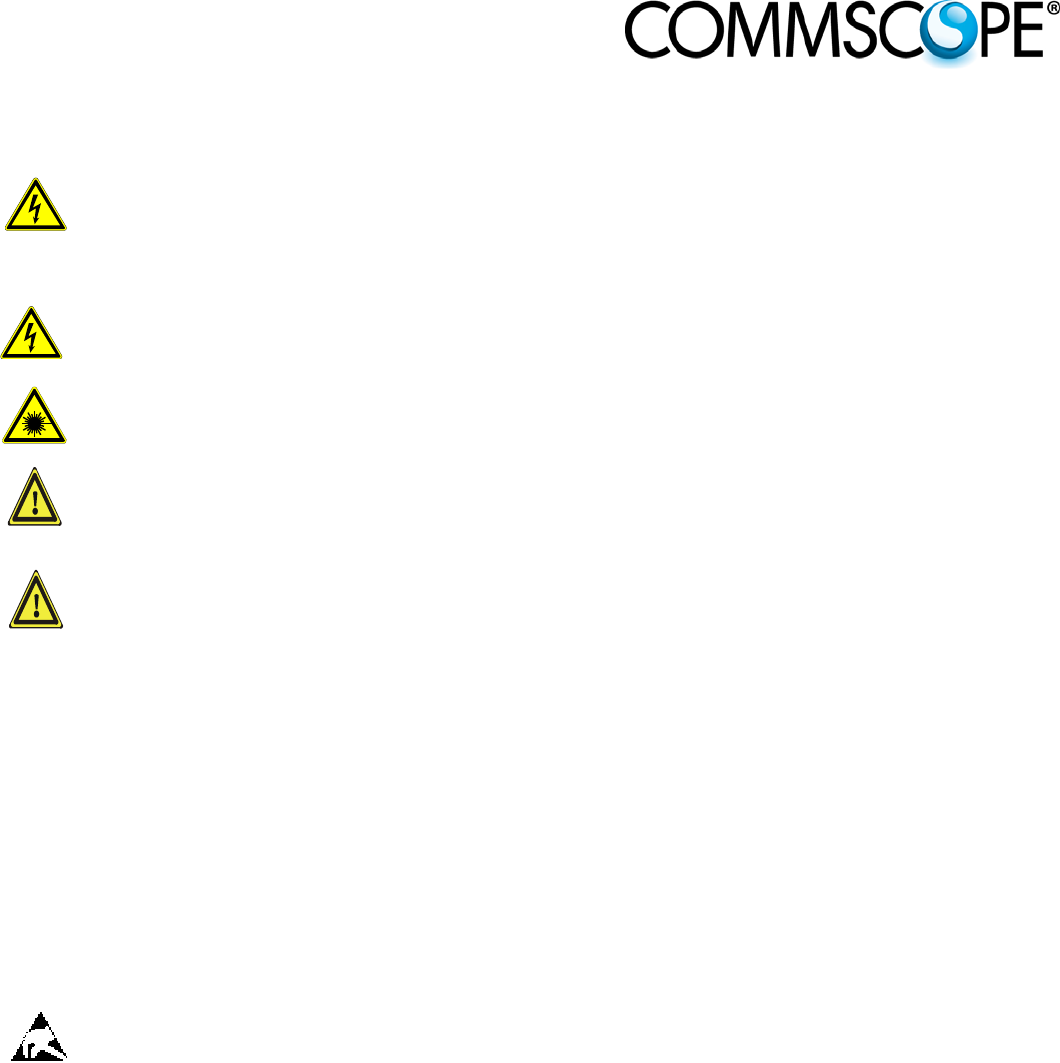
1.3. HEALTH AND SAFETY WARNINGS
1. Danger: Electrical hazard. Danger of death or fatal injury from electrical current. Obey all
general and regional installation and safety regulations relating to work on high voltage
installations, as well as regulations covering correct use of tools and personal protective
equipment.
2. Danger: Electrical hazard. Danger of death or fatal injury from electrical current inside the
unit in operation. Before opening the unit, disconnect mains power.
3. Caution: Laser radiation. Risk of eye injury in operation. Do not stare into the beam; do not view it
directly or with optical instruments.
4. Caution: High frequency radiation in operation. Risk of health hazards associated with radiation
from the unit’s inner conductor of the antenna port(s). Disconnect mains before connecting or
replacing antenna cables.
5. Caution: High frequency radiation in operation. Risk of health hazards associated with radiation
from the antenna(s) connected to the unit. Implement prevention measures to avoid the possibility of
close proximity to the antenna(s) while in operation.
1.3.1. Property Damage Warnings
1. Attention: Due to power dissipation, the remote unit may reach a very high temperature. Do not
operate this equipment on or close to flammable materials. Use caution when servicing the unit.
2. Attention: Only authorized and trained personnel are allowed to open the unit and get access to the
inside.
3. Notice: Although the remote unit is internally protected against overvoltage, it is strongly
recommended to ground (earth) the antenna cables close to the repeater’s antenna connectors for
protection against atmospheric discharge.
4. Notice: ESD precautions must be observed. Before commencing maintenance work, use the
available grounding (earthing) system to connect ESD protection measures.
5. Notice: Only suitably qualified personnel are allowed to work on this unit and only after becoming
familiar with all safety notices, installation, operation and maintenance procedures contained in this
manual.
6. Notice: Keep operating instructions within easy reach and make them available to all users.
7. Notice: Read and obey all the warning labels attached to the unit. Make sure that all warning labels
are kept in a legible condition. Replace any missing or damaged labels.
8. Notice: Only license holders for the respective frequency range are allowed to operate this unit.
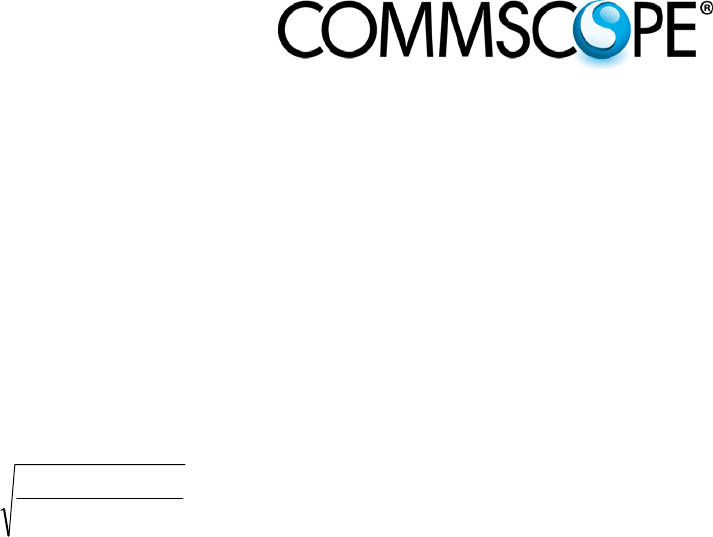
9. Notice: Make sure the repeater settings are correct for the intended use (refer to the manufacturer
product information) and regulatory requirements are met. Do not carry out any modifications or fit
any spare parts, which are not sold or recommended by the manufacturer.
1.3.2. Compliance
1. Notice: For installations, which have to comply with FCC RF exposure requirements, the
antenna selection and installation must be completed in a way to ensure compliance with
those FCC requirements. Depending on the RF frequency, rated output power, antenna
gain, and the loss between the repeater and antenna, the minimum distance D to be
maintained between the antenna location and human beings is calculated according to this
formula:
]/[
][
][
2
4cmmW
mW
cm PD
P
D
where
P (mW) is the radiated power at the antenna, i.e. the max. rated repeater output power in
addition to the antenna gain minus the loss between the repeater and the antenna.
PD (mW/cm²) is the allowed Power Density limit acc. to 47 CFR 1.1310 (B) for general
population / uncontrolled exposures which is
o F (MHz) / 1500 for frequencies from 300MHz to 1500MHz
o 1 for frequencies from 1500MHz to 100,000MHz
RF exposure compliance may need to be addressed at the time of licensing, as required by the
responsible FCC Bureau(s), including antenna co-location requirements of 1.1307(b)(3).
2. Notice: For installations which have to comply with European EN50385 exposure compliance
requirements, the following Power Density limits/guidelines (mW/cm²) according to ICNIRP are
valid:
o 0.2 for frequencies from 10 MHz to 400 MHz
o F (MHz) / 2000 for frequencies from 400 MHz to 2 GHz
o 1 for frequencies from 2 GHz to 300 GHz
3. Notice: Installation of this equipment is in full responsibility of the installer, who has also
the responsibility, that cables and couplers are calculated into the maximum gain of the
antennas, so that this value, which is filed in the FCC Grant and can be requested from the
FCC data base, is not exceeded. The industrial boosters are shipped only as a naked
booster without any installation devices or antennas as it needs for professional installation.

4. Notice: For installations which have to comply with FCC/Industry Canada requirements:
English:
This device complies with FCC Part 15 and Industry Canada license exempt RSS standard(s).
Operation is subject to the following two conditions: (1) this device may not cause interference, and
(2) this device must accept any interference, including interference that may cause undesired
operation of the device.
This device complies with Health Canada’s Safety Code. The installer of this device should
ensure that RF radiation is not emitted in excess of the Health Canada’s requirement.
Information can be obtained at http:
//www.hc-sc.gc.ca/ewh-semt/pubs/radiation/radio_guide-lignes_direct-eng.php.
Changes or modifications not expressly approved by the party responsible for compliance
could void the user’s authority to operate the equipment.
French:
Cet appareil est conforme à FCC Partie15 d’Industrie Canada RSS standard exempts de licence (s).
Son utilisation est soumise à Les deux conditions suivantes: (1) cet appareil ne peut pas provoquer
d’interférences et (2) cet appareil doit accepter Toute interférence, y compris les interférences qui
peuvent causer un mauvais fonctionnement du dispositif.
Cet appareil est conforme avec Santé Canada Code de sécurité 6. Le programme d’installation de
cet appareil doit s’assurer que les rayonnements RF n’est pas émis au-delà de I’exigence de Santé
Canada. Les informations peuvent être obtenues:
http://www.hc-sc.gc.ca/ewh-semt/pubs/radiation/radio_guide-lignes_direct-fra.php
Les changements ou modifications non expressément approuvés par la partie responsable
de la conformité pourraient annuler l'autorité de l'utilisateur à utiliser cet équipement.
5. Notice: The unit complies with Overvoltage Category II. It also complies with the surge
requirement according to EN 61000-4-5 (fine protection); however, installation of an
additional medium (via local supply connection) and/or coarse protection (external surge
protection) is recommended depending on the individual application in order to avoid
damage caused by overcurrent.
For Canada and US, components used to reduce the Overvoltage Category shall comply
with the requirements of IEC 61643-series. As an alternative, components used to reduce
the Overvoltage Category may comply with ANSI/IEEE C62.11, CSA Certification Notice
No. 516, CSA C22.2 No. 1, or UL 1449. Suitability of the component for the application
shall be determined for the intended installation.
6. Notice: Corresponding local particularities and regulations must be observed. For national
deviations, please refer to the respective documents included in the manual CD that is
delivered with the unit.
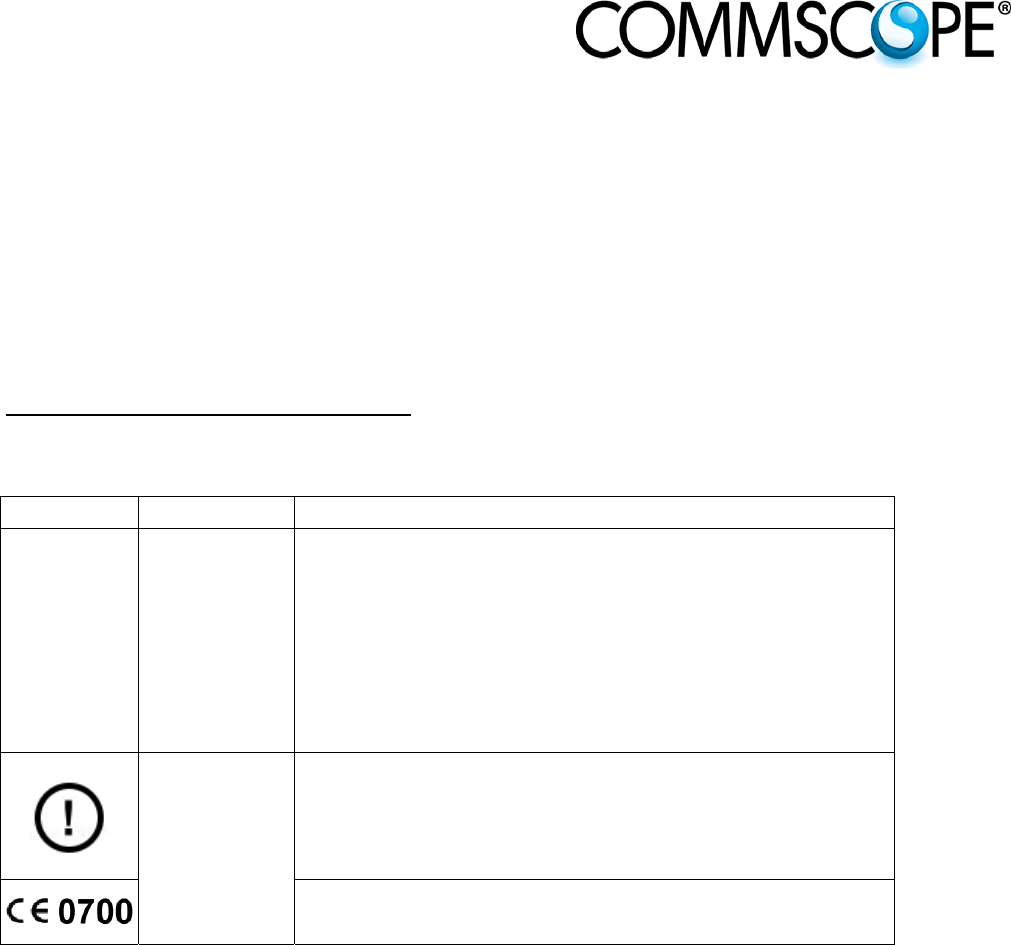
7. Note: For a Class A digital device or peripheral:
This equipment has been tested and found to comply with the limits for a Class A digital device,
pursuant to part 15 of the FCC Rules. These limits are designed to provide reasonable protection
against harmful interference when the equipment is operated in a commercial environment. This
equipment generates, uses, and can radiate radio frequency energy and, if not installed and used in
accordance with the instruction manual, may cause harmful interference to radio communications.
Operation of this equipment in a residential area is likely to cause harmful interference in which case
the user will be required to correct the interference at his own expense.
8. Note: This unit complies with European standard EN60950.
Equipment Symbols Used / Compliance
Please observe the meanings of the following symbols used in our equipment and the compliance
warnings:
Symbol Compliance Meaning / Warning
--- FCC
For industrial (Part 20) signal booster:
WARNING: This is NOT a CONSUMER device. It is
designed for installation by FCC LICENSEES and
QUALIFIED INSTALLERS. You MUST have an FCC
LICENSE or express consent of an FCC Licensee to
operate this device. Unauthorized use may result in
significant forfeiture penalties, including penalties in excess
of $100,000 for each continuing violation.
CE
Alert sign to R&TTE
To be sold exclusively to mobile operators or authorized
installers – no harmonized frequency bands, operation
requires license. Intended use: EU and EFTA countries.
Indicates conformity with the R&TTE directive 1999/5/EC
certified by the notified body no. 0700.